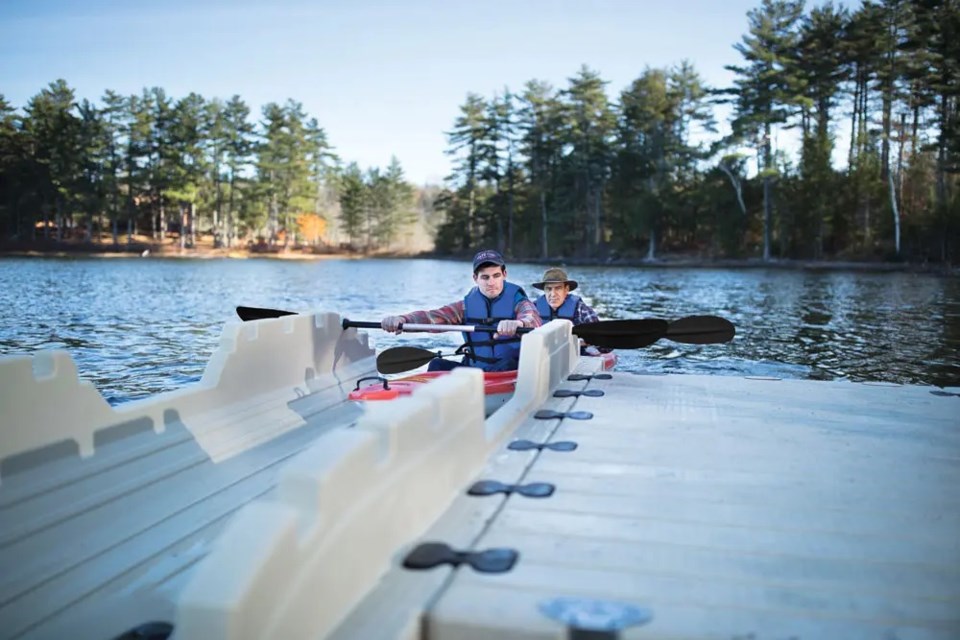When you are on the back roads there is no truly graceful way to get in and out of a kayak, or a canoe for that matter. It will get easier and looks more effortless with practice and experience if you have one of these docks.
The answer is close at hand. This summer the Lakehead Region Conservation Authority (LRCA) in Thunder Bay put into service a floating dock with an innovative attached launch that that makes entering and exiting more convenient by keeping the kayaks and canoes stable. Seeing is believing.
Although the canoe is a Canadian icon. Recreational kayaking has been the most popular of the paddle sports for several years, according to the Outdoor Industry Foundation. And during COVID-19, that popularity exploded as people have been getting outside more than ever.
Modular docks
"There is almost no risk of tipping with this docking system, you’re in the water but you're being supported by the bottom of the launch module,” said Ryan Mackett, Communications Manager for the LRCA. “We are meeting the needs of kayakers and increasing use of our conservation areas.
“After receiving some funding to install an accessible kayak launch and floating dock at Hurkett Cove Conservation Area, we decided that similar infrastructure would work exceptionally well at Hazelwood Lake Conservation Area, as that spot is an ideal paddling location. Providing improved access to the lake at an already popular location was part of the reasoning; however, this system allowed for us to potentially remove barriers to people who may have some mobility issues accessing the water.”
He said the system works exceptionally well. “Essentially, a solid floating cradle is affixed to the side of the modular, floating dock system. A paddler places their kayak or canoe into the floating cradle and steps into it from the dock without fear of tipping. Once settled in the vessel, the paddler uses their horizontal paddle to pull themselves out of the cradle and into the water by notching the oar into cut-outs in the sides of the cradle. To leave the water, simply paddle into the cradle and use the same notches to pull yourself back into place and then safely step out of your vessel and back onto the floating dock.”
LRCA is planning for more. “We have a similar system budgeted for 2024 to be installed at Little Trout Bay Conservation Area. Additionally, we would like to see one installed within the Neebing-McIntyre Floodway within the City of Thunder Bay, which is another popular paddling area.”
More benefits
EZ Dock is a part of PlayPower, Inc., one of the world’s largest recreational manufacturers and innovators of these docking systems.
Chad Dailey is from EZ Dock Ontario within the dealer network. Since 2004 they have been selling the accessible version. “EZ Dock has been at forefront of this modular dock system, it was invented by a person with multiple sclerosis and EZ Dock put the concept into production.
He said summer children’s camps are also using the stable launch feature for the small Laser Performance sailboats. And paddle board enthusiasts, while sitting, can also use the launch system.
“It is made of the same material as Tupperware with a UV inhibitor and is manufactured from virgin plastic so contaminants are not an issue for water quality. Adult Lego, we call it. We can change the configuration on the fly. Just from our own figures sales have increased 60 per cent year over year,” he said.
Back at CA Ryan listed the features that paddlers have identified about the modular docks. “One is the paddle notches. The integrated paddle notches make launching easy and safe while users are entering or exiting the kayak. “It allows the paddler to centre and stabilize your kayak for an easy launch.”
Many canoeists now use a kayak paddle to increase stroke efficiency.
“We do not have to worry about changing lake water levels as the docks rise and fall with weather events and water control dams.”
Ryan says the seamless docks are really like Chad’s reference to Lego, “It is designed to be easy to connect.”
The CA likes that the docks are made from polyethylene and recycled rubber (truck tires with nylon threads) both recyclable and there is the aspect of low maintenance. “Unlike wooden docks, the materials won’t splinter or peel, meaning we won’t have to repaint it or replace rotten planks — the CA puts them in and out of the water with an ATV.”
Listen to the CBC Fresh Air interview with Ryan. Find out more about these docks.
These docks and the LRCA story will be featured at the Conservation Areas Workshop at the Fern Resort in Rama, Ontario, on October 24-26, there will be representation from all 36 Ontario Conservation Authorities.
More than ever there are an increasing number of New Canadians and retirees, all looking to try paddling. Ryan predicts you will start to see more of these docking systems, especially within CA’s, municipal and government-regulated parks.
Back Roads Bill has had some knee issues lately and will try this launch in 2024. Someone was thinking that day and with that comes innovation. "Is there a graceful way to get in and out of my kayak?" This might be the answer on the back roads or at your camp or cottage.



